Key takeaways
- Chicago rap music reflects the city’s socio-economic challenges, utilizing themes of struggle, resilience, and authenticity.
- Chief Keef is a pivotal figure in Chicago rap, known for his raw storytelling and significant influence on the drill genre.
- The genre has a profound cultural impact, shaping youth culture, fashion, and social commentary while providing a voice for marginalized communities.
- Chief Keef’s “Finally Rich” blends trap and drill elements, showcasing his unique style and addressing themes of wealth, street life, and authenticity.

Overview of Chicago rap music
Chicago rap music has a rich and diverse history that reflects the city’s unique cultural landscape. Coming from a background filled with socio-economic challenges, many artists use their music as a platform to express their realities and emotions. For instance, I’ve always been struck by how artists like Chief Keef have turned their life experiences into powerful storytelling, making listeners feel the weight of their journey.
The scene is characterized by its authenticity and raw emotion. Artists often delve into themes of struggle, resilience, and triumph, making it easy for listeners to connect with the music on a personal level. I remember discovering local acts that painted vivid pictures of life in Chicago, which really demonstrated the impact of the environment on their artistry.
Here’s a brief comparison of notable sub-genres within Chicago rap music:
| Sub-genre | Description |
|---|---|
| Drill | A raw, aggressive style that emerged in the early 2010s, focusing on street life and real experiences. |
| Conscious Rap | Emphasizes social issues and personal growth, often reflecting on life lessons and a desire for change. |
| Alternative Rap | Explores eclectic sounds and themes, merging traditional rap with various musical influences. |

Key artists in Chicago rap
When I think of key artists in Chicago rap, Chief Keef immediately comes to mind. His unique style and raw lyrical content have shaped the sound of the city’s music scene. I remember the first time I heard “I Don’t Like”; the energy was infectious, and it truly captured the pulse of Chicago’s streets, resonating with both fans and artists alike.
In addition to Chief Keef, Chicago rap is rich with diverse talent that deserves recognition. Artists like Chance the Rapper and Lil Durk have also made significant contributions, showcasing different perspectives and styles that reflect the city’s complex culture. Their music often tells stories that are raw and relatable, taking listeners on a journey through their personal experiences.
- Chief Keef: Pioneer of the drill movement, bringing a gritty realism to his music.
- Chance the Rapper: Known for his innovative approach to music distribution and positive messages.
- Lil Durk: Often focuses on themes of struggle and perseverance in his lyrics.
- G Herbo: Brings a narrative-driven style, highlighting street life and authenticity.
- Juice WRLD: Merged emo and rap, emotionally resonating with a younger generation while exploring mental health themes.
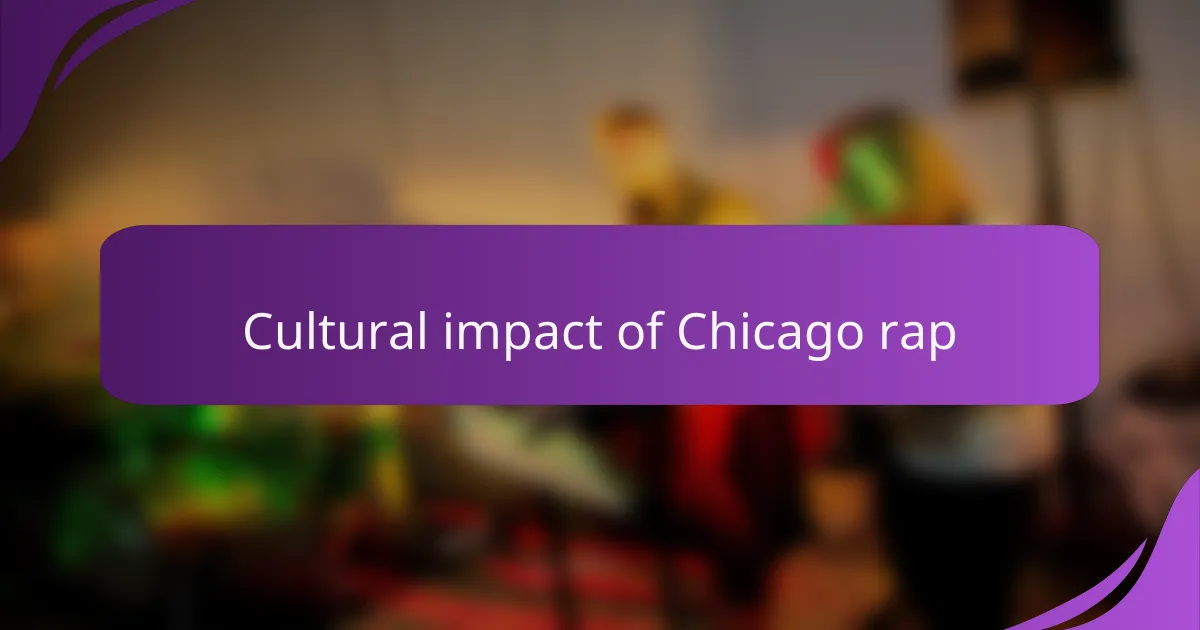
Cultural impact of Chicago rap
Chicago rap has had a profound cultural impact, serving as a voice for communities often overlooked in mainstream narratives. Artists like Chief Keef have brought raw, honest experiences to the forefront, capturing the struggles and aspirations of urban life. I remember the first time I heard “I Don’t Like”; it was like a revelation – the aggression and authenticity resonated with me, illustrating the harsh realities and raw emotions that many face.
The emergence of Chicago rap has not only shifted music trends but has also influenced fashion, language, and even social movements. Here are some ways this genre has made its mark:
- Community Voice: Elevates stories from Chicago’s neighborhoods, providing a platform for local artists.
- Youth Culture: Shapes fashion and slang, impacting how youth express themselves.
- Social Commentary: Highlights issues like violence and inequality, stimulating dialogues around these topics.
- Innovative Sound: Blends genres, introducing unique styles like drill, influencing artists worldwide.
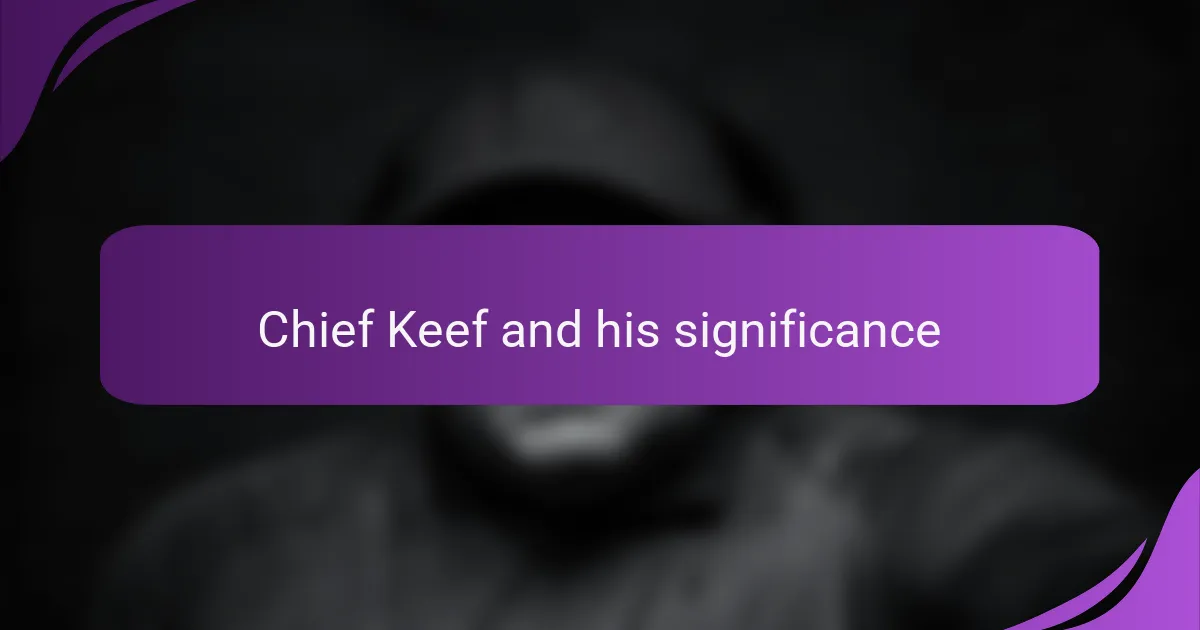
Chief Keef and his significance
Chief Keef stands as a pivotal figure in the Chicago rap scene, reshaping the landscape with his unique style and sound. His debut album, “Finally Rich,” released in 2012, marked a significant moment not just for him, but for the drill music genre as a whole. Personally, I remember the first time I heard “I Don’t Like” — it was raw, unapologetic, and it sparked an instant connection to the gritty reality many artists were trying to convey.
Moreover, Chief Keef’s influence extends beyond music; he embodies a voice for the youth of Chicago, highlighting the struggles they face while also celebrating their resilience. His unique ability to blend catchy hooks with hard-hitting lyrics creates a sonic experience that resonates deeply with fans. It’s fascinating how one artist can encapsulate the spirit of a movement, and I’ve seen firsthand how his music has inspired countless aspiring rappers in the city.
Here’s a comparison of Chief Keef’s early work and its impact on the Chicago rap scene versus contemporary artists and their styles:
| Chief Keef’s “Finally Rich” | Contemporary Chicago Rap Artists |
|---|---|
| Raw, authentic portrayal of street life | Blends various genres with more commercial appeal |
| Focus on drill music and its cultural roots | Diverse influences, including R&B and pop |
| Influenced a generation of young rappers | Innovative sounds and collaborations |
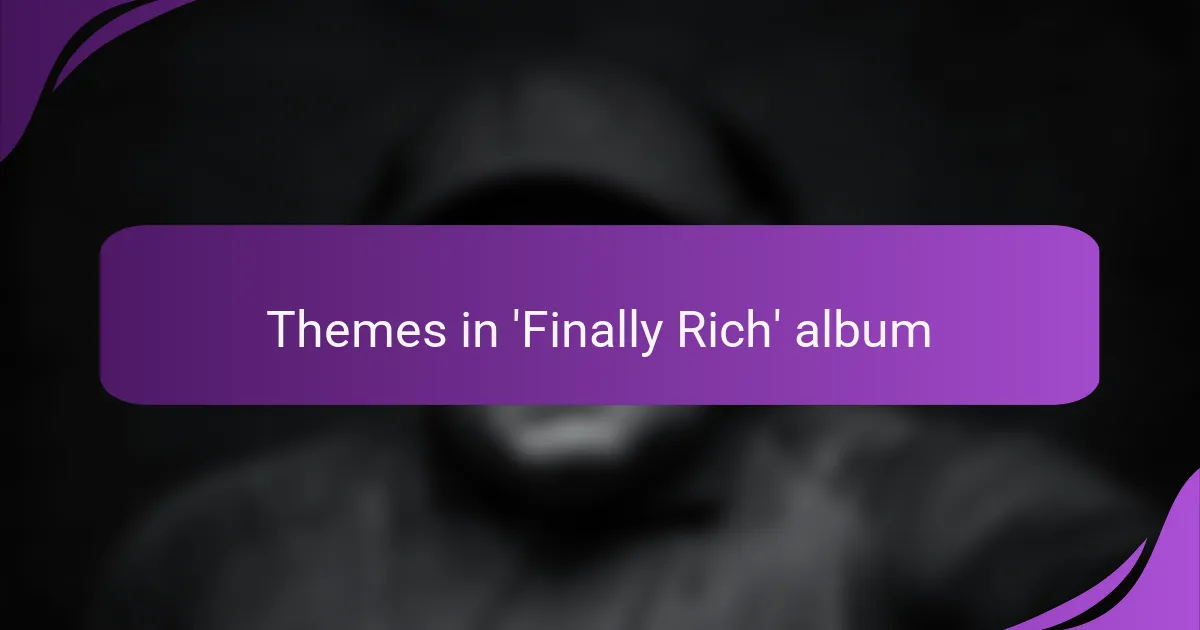
Themes in ‘Finally Rich’ album
The themes in Chief Keef’s “Finally Rich” delve into the struggles and triumphs of his life experiences, offering a raw glimpse into his rise from the streets of Chicago. Listening to tracks like “I Don’t Like,” I felt an immediate connection to the aggressive portrayal of street life. It reminds me of how music can serve as both an escape and a reflection of one’s reality, and Keef captures that brilliantly.
Throughout the album, recurrent themes highlight wealth, fame, and the challenges of living in an unforgiving environment. The songs are infused with a sense of urgency and a desire for validation that resonates deeply with listeners. Here are some of those prevalent themes:
- Wealth and Success: Celebrating newfound riches while grappling with the changes it brings.
- Street Life: The harsh realities and experiences that shape his identity and music.
- Isolation: Despite fame, there’s a recurring feeling of loneliness and the challenge of maintaining genuine relationships.
- Youth and Rebellion: Capturing the carefree yet chaotic essence of youth, reflecting mischief and defiance.
- Authenticity: A strong emphasis on staying true to oneself amidst external pressures.
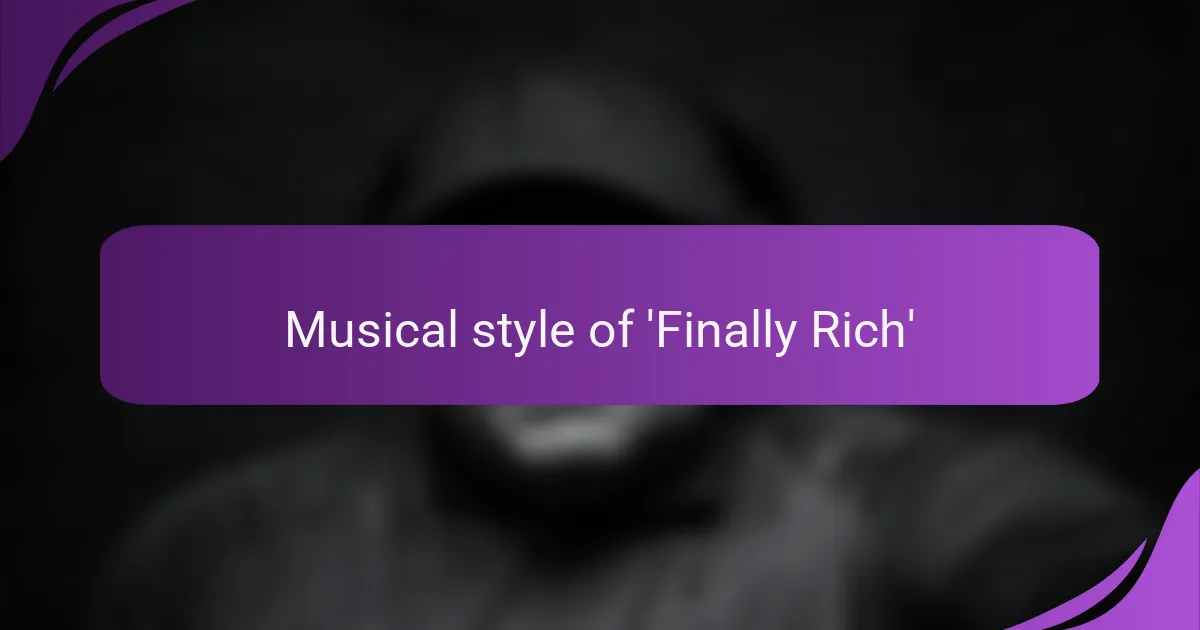
Musical style of ‘Finally Rich’
The musical style of “Finally Rich” is a striking blend of trap beats and drill influences, which perfectly encapsulates Chief Keef’s raw energy and streetwise tales. I remember the first time I heard the production on tracks like “I Don’t Like”—the heavy bass and sharp hi-hats instantly pulled me into an immersive world. It’s fascinating how this album doesn’t just sound modern; it echoes the very realities of urban life, showcasing a sonic landscape that’s both aggressive and captivating.
Keef’s delivery is what sets him apart, embodying a laid-back confidence that contrasts sharply with the intensity of his lyrics. His use of repetitive hooks is almost hypnotic, making songs like “Love Sosa” anthem-like, inviting listeners to shout along. I think this approach not only makes the music memorable but also helps convey his experiences in a way that’s highly relatable, especially to those familiar with the lifestyle he describes.
Musically, “Finally Rich” also allows for experimentation within the drill genre, incorporating elements like melodic flows and unexpected shifts in rhythm. It’s interesting how Keef’s storytelling transcends mere entertainment; it serves as a commentary on the complexities of life in Chicago. I often find myself reflecting on how powerful a few simple beats can become when paired with authentic narratives, elevating the entire listening experience.
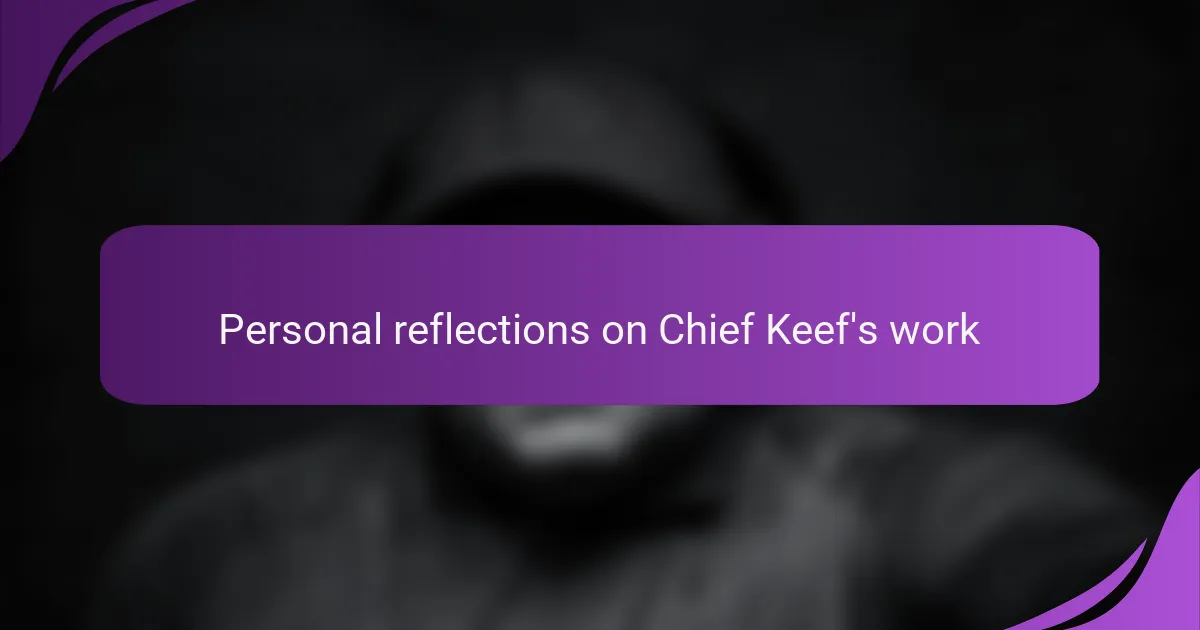
Personal reflections on Chief Keef’s work
Chief Keef’s work resonates with me on various levels, particularly in how he articulates the gritty realities of life in Chicago. When I first listened to “Finally Rich,” I was struck by his ability to transform personal pain into relatable narratives. It sparked a profound realization about how music can not only reflect our struggles but also become a form of catharsis. Have you ever had a song just speak to your life’s experiences? That’s how I felt with Keef—he captures the raw essence of street life and the heartache that often accompanies it.
One of the most compelling aspects of his music is the sheer authenticity he brings to every track. The themes of wealth and the rollercoaster of emotions tied to newfound success often force me to reconsider the cost of fame. Listening to “Love Sosa,” I find myself wondering—does success truly bring freedom, or does it just come with new chains? Keef’s lyrics challenge us to confront those complexities, making his music as thought-provoking as it is entertaining.
There’s something undeniably special about the way Chief Keef intertwines his life experiences with his sound. I can recall moments where his lyrics became a soundtrack to my own reflections. In tracks where he explores isolation, I recognized my own feelings of loneliness even when surrounded by others. It’s this deep connection that makes his work more than just music; for me, it’s a lens through which I can better understand the labyrinth of emotions that accompany the human experience.
